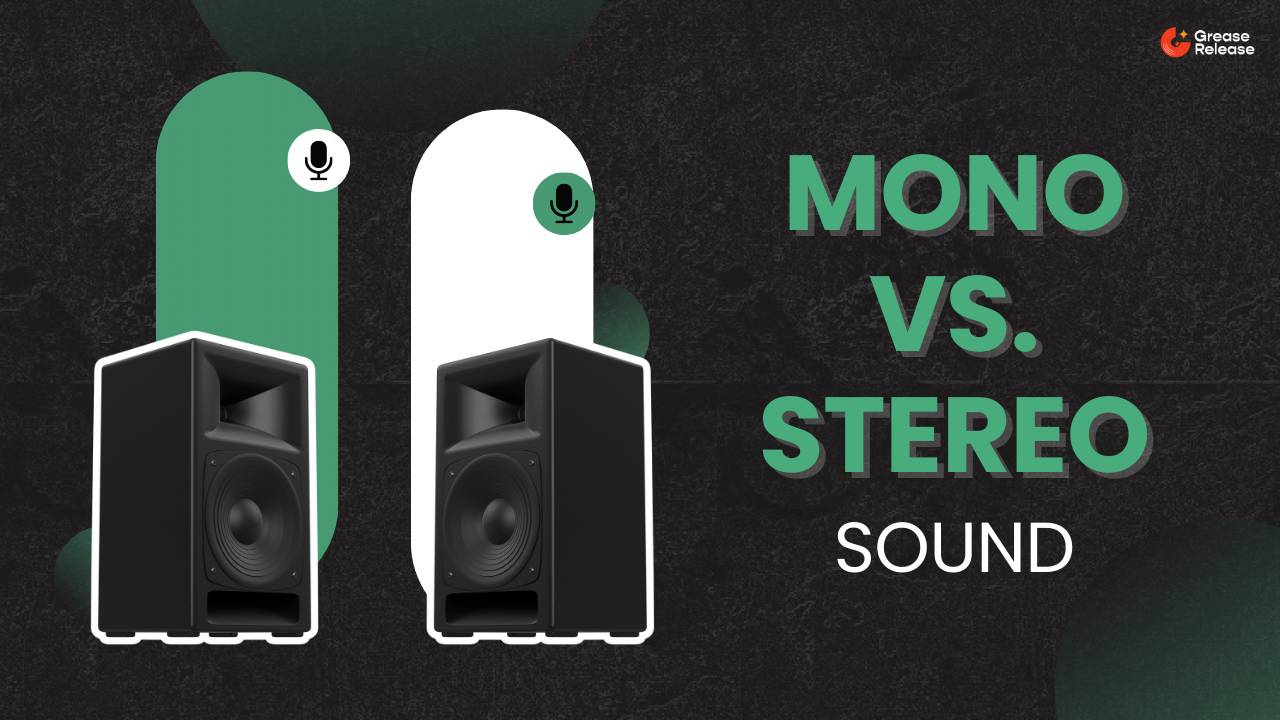
Difference between Mono and Stereo Audio (Simplified)
Sep 18, 2025Mono vs. Stereo: Which one should you choose?
Have you ever wondered why some audio sounds flat while other tracks feel like they surround you? The answer lies in mono vs stereo sound. These two formats are fundamental to how we perceive sound, and they can dramatically change the way we enjoy music, podcasts, films, and live performances.
Whether you’re a musician mixing tracks, a podcaster setting up a mic, or simply a music lover curious about why headphones sound so immersive, understanding mono v stereo sound is essential.
In this guide, we’ll break down what stereo and mono sound mean, how they differ, their benefits, and which one you should use depending on your purpose ~
- What is Mono Audio?
- What is Stereo Audio?
- Mono v Stereo — The Key Differences
- Benefits of Mono
- Benefits of Stereo
- Which One Should You Choose?
- Final Thoughts

What is Mono Audio?
Simple Definition
Mono audio (short for monophonic audio) means a single channel of audio. In practical terms, this means that the exact same sound is sent to every speaker or headphone, regardless of how many are connected. Play a mono track through two speakers, and both will output an identical signal.
Characteristics
Think of this like everyone in a room hearing the same voice from the middle — simple, consistent, and clear.
- Mono creates a uniform sound field where everything is centered in the mix.
- There is no sense of left or right movement in the audio because everything is blended into one channel.
- Easier to balance since all sound comes from one place.
Use Cases
- Podcasts & Talk Shows: Mono keeps voices crisp and consistent across all devices.
- Public Address Systems: Concerts, stadiums, and venues often use mono for reliability.
- Background Music: Shops, restaurants, and cafes use mono so that the music sounds the same everywhere.
What is Stereo Audio?
Simple Definition
Stereo (short for stereophonic) uses two separate audio channels: left and right. Each channel can carry different information, allowing sounds to be positioned within a spatial field, creating a sense of direction and space. For example, a guitar might be placed slightly to the left, while drums occupy the right, and vocals remain in the center.
Characteristics
Imagine sitting in a concert hall where drums are to your left, guitars to your right, and vocals in the center - that’s stereo!
- Stereo creates a wider, more immersive listening experience.
- Since the audio can be distributed between the left and right channels, it gives the illusion of space and direction.
- More natural and realistic listening experience because it mimics how our ears naturally hear sound in the real world, where noises come from different angles and distances.
Use Cases
- Music Playback & Production: Stereo creates depth and separation between instruments.
- Film & Gaming: Directional sound enhances realism and immersion.
- Headphones & Home Speakers: Stereo takes advantage of left/right separation.
- Concert Recordings & Streams: Captures the atmosphere of a live performance.
Mono v Stereo — The Key Differences

While both stereo and mono sound have their place, they offer very different listening experiences. So let’s break down the difference between mono and stereo audio based on some important aspects ~
1. Sound experience:
- Mono feels flat and centered, as if all the sound is coming from one spot. Listening to a mono track is like hearing a single voice directly in front of you.
- Stereo, on the other hand, spreads the audio across space, giving a sense of direction and depth. It feels like being in a room where different sounds are coming from different directions.
2. Equipment and setup:
- Mono is simpler. A single microphone or channel can capture everything, and playback doesn’t require careful speaker placement.
- Stereo requires at least two channels and benefits from proper speaker alignment to achieve the best effect.
3. File size and compatibility:
- Mono files are typically smaller because they contain only one channel of data. This makes them more efficient for older systems or for streaming in low-bandwidth environments.
- Stereo files are larger but are now the industry standard, as modern devices are built to handle them easily.
4. Mixing and production:
- Mono is often used as a reference check. Producers will listen in mono to ensure the track is balanced and doesn’t lose clarity when collapsed into one channel.
- Stereo, however, offers more creative possibilities like panning instruments, adding spatial effects, and creating immersive soundscapes that draw listeners in.
Now that you know the difference, you must be wondering which one you should choose. For that, keep reading as we’ve answered exactly that in a separate section below!
Benefits of Mono
Mono may seem old-fashioned, but it comes with several advantages:
- Consistency Across Devices: Whether someone listens on a phone speaker, car stereo, or PA system, mono ensures they hear the same balanced audio.
- Ease of Recording and Mixing: With only one channel to manage, recording setups are simpler and mixing is less complex.
- Lower Costs and Storage Needs: Mono files take up less space, making them easier to share and store, especially in bandwidth-limited situations.
- Clarity in Noisy Environments: Mono cuts through background noise more effectively, making it the preferred choice for public announcements and live events.
- Ideal for Speech and Voice Content: Since human voices don’t need spatial effects, mono is perfect for podcasts, interviews, audiobooks, and commentary.
Benefits of Stereo
Stereo dominates modern audio because of the benefits it provides:
- Immersive Listening: Stereo creates a spacious sound that feels more natural, mimicking how we hear in real life.
- Emotional Impact: The depth and directionality of stereo sound can make music more powerful and films more dramatic.
- Creative Freedom in Production: Producers can experiment with panning, reverb, and layering to craft unique soundscapes.
- Enhanced Realism in Media: For gaming and movies, stereo helps replicate environments, making actions and effects feel real.
- Engagement for Listeners: Stereo keeps the listener’s attention by offering variety and detail, making it more enjoyable for personal music listening.|
Which One Should You Choose?
For Musicians & Producers
If you’re a musician or producer, the ‘stereo versus mono’ decision can really change the game. A stereo is the standard for creating tracks with richness and depth.
However, you should still check your mix in mono to make sure it sounds good everywhere - on car radios, phone speakers, or club sound systems that may not fully reproduce stereo separation. Think of stereo as your canvas for creativity, and mono as your reality check for consistency.
For Podcasters & Voice Creators
For podcasters, interviewers, and voice-based creators, mono is almost always the better choice. It ensures that speech remains clear and uniform across all playback systems. Since your audience is tuning in for words, not immersive effects, stereo doesn’t add value.
For General Listening
For everyday listeners, the choice between stereo versus mono often depends on context. If you’re listening on headphones or a home stereo system, stereo will give you the best experience. But in environments like cafes, gyms, or live venues, mono ensures everyone hears the same balanced audio.
Final Thoughts
Ultimately, it’s not about stereo versus mono and which is “better,” but which one serves your purpose better. Mono provides simplicity and reliability, while stereo delivers depth and excitement. The smartest creators often use both strategically. They record or mix in stereo, but also check and sometimes release in mono where consistency matters.
- Choose mono if you need clarity, simplicity, and consistency.
- Choose stereo if you want depth, immersion, and a more natural listening experience.
At the end of the day, both play a vital role in audio. Musicians, podcasters, and listeners all benefit from understanding when to use mono and when stereo shines.
We at GreaseRelease, have a bunch of curators on our network who are looking for new & exciting music to push on their massive playlists. If you make music and want to reach a wider audience, check out our submission platform and get a chance to reach millions of listeners! Submit your tracks now!
Don't miss my newsletter!
Join me on a music entrepreneurship journey with new tips and tricks delivered straight to your inbox.
We hate SPAM. We will never sell your information, for any reason.




